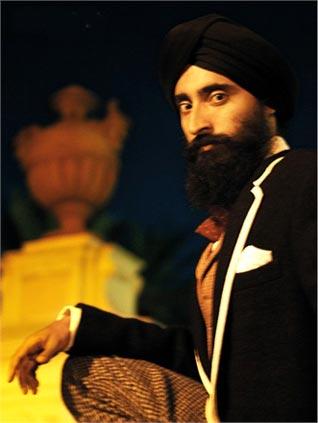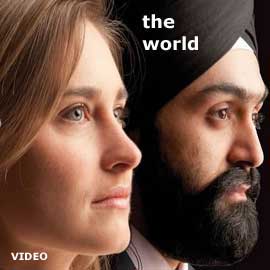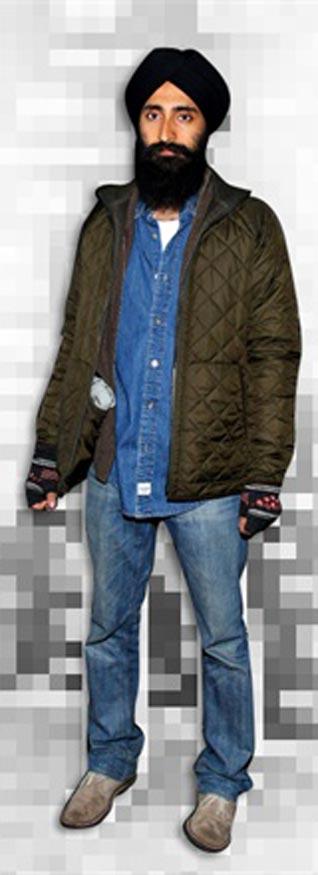Fashion
VOGUE: Waris Ahluwalia
"A True Masculine Icon for The 21st Century"
An Interview by SABINE HELLER
INTRO
Fiamma Sanò (edited by Lella Scalia)
It's not just the turban the makes Waris Singh Ahluwalia's
look so iconic; nor is it his full, black beard. It's a combination of
those, with his superslim suits in grey, electric blue or bordeaux with
contrasting white shoes. Or his shabby-dandy scarf tied around his neck,
or his all-denim looks in which he mixes light and dark.
While his name is difficult to remember, Waris Ahluwalia's face is impossible to forget. He's become an iconic actor for supercool indie directors
like Wes Anderson, for whom Waris played the imperturbable head steward
of the Darjeeling Limited, and before that, the part Vikram Ray, the
Sikh cameraman of Team Zissou in the Life Aquatic. Waris has also appeared in Spike Lee's Inside Man and I Am Love by Luca Guadagnino.
Born in 1975, in the city of Amritsar in Punjab, he moved to Brooklyn at the age of five with his parents, who were both university professors.
He
calls himself a "part-time actor", as the other part of his time is
dedicated to designing jewelry for his House of Waris line. His
pieces are made my craftspeople in India and Rome and are carried in
the world's most exclusive boutiques. Under the same name, Waris has
also opened a tea room in New York.
His icon status is not only thanks to his style (he was number 15 on Vanity Fair's Best-Dressed List in 2010), but to his vast and varied social connections. He's
a definitive example of the modern-day jet-setter, and has been a fixture
on New York's coolest nightlife scene since he was a teenager. It's the social scene that's allowed him to solidify he's most important relationships.
Besides
Wes Anderson, his close circle of friends include Chiara Clemente, the
street artist André and Paul Sevigny, Chloë's brother, as well as the
owner of the Beatrice Inn, the restaurant in the Village, a gathering
point for the art and fashion worlds and according to New York Magazine,
"the hippest place in town". If you're looking for Waris, that's where
you should hang out.
THE INTERVIEW
Sabine Heller
What is your background?
"I spent the first five years of my life in Punjab and then moved to New York."
What do you do?
"I'm an explorer."
In greater detail ...?
"Well, I have a jewelry line called the House of Waris. I'm also an actor."
Tell me about the turban.
"I'm a Sikh, its part of my religious tradition to never cut my hair and keep it wrapped in a turban."
Do you ever take it off?
"Yes, when I sleep, shower and sex. Not in that particular order. Also swimming. Oddly all with an "S."
How did you first start making jewelry?
"I
never intended on designing jewelry. I had two rings made for myself
with 40 diamonds in each ring. I was at Maxfields in LA and the rings
caught the attention of the sales staff. The rest is history. I didn't
choose this path. Jewelry chose me."
Do you come from a tradition of jewelry making?
"No, it's not in my family and I'm not formally trained. It must be in the stars."
What makes jewelry beautiful to you?
"It's
jewelry and pottery that archeologists find on their digs. It's working
in forever that I like - working with objects of beauty that become an
intimate part of someone's life. I work with gold that holds history,
diamonds that see the future, and rubies that long for love."
How did you start acting?
"Acting
found me just as jewelry did. One afternoon Wes asked me to be in his
movie. Life Aquatic was the first movie I did and it's been an
incredible adventure since then."
Next film?
"It's a secret for now."
Tell me about your photo book, "To India, With Love" .
"We're
all here for what is a spark of a moment. If I can bring beauty, hope
and joy to the world around me I shall have served my purpose. We acted
in response to the attack on Mumbai in 2008 and all proceeds went to the
Taj Memorial Public Service Welfare Trust, which is aiding victims and
families that suffered through the attacks. We also wanted the milkman
to read in his local paper feel that there were people on the other side
of the world sending their love and care."
You've dabbled in many things over the years.
"Yes, magazines, non-profit work, film production, to name a few."
Have you failed at any?
"Yes, on occasion."
What's the value of failure?
"At
the very least, failure provides the greatest opportunity for learning.
It gives you a chance to stand up and try again. This should sum up how I
feel:
"It is not the critic who counts; not the man who points
out how the strong man stumbles, or where the doer of deeds could have
done them better. The credit belongs to the man who is actually in the
arena, whose face is marred by dust and sweat and blood; who strives
valiantly; who errs, who comes short again and again, because there is
no effort without error and shortcoming; but who does actually strive to
do the deeds; who knows great enthusiasms, the great devotions; who
spends himself in a worthy cause; who at the best knows in the end the
triumph of high achievement, and who at the worst, if he fails, at least
fails while daring greatly, so that his place shall never be with those
cold and timid souls who neither know victory nor defeat." [Theodore Roosevelt, Citizenship in a Republic, Speech at the Sorbonne, Paris, France, April 23, 1910]
What are you most afraid of?
"There's
no reason for allowing fear into our lives. It just holds us back. Our
time here is too short to submit to fear. Ok, maybe I'm afraid of the
big bad wolf."
What was the turning point in your career?
"I
do what makes me happy and nourishes my soul and those along with me on
this journey. How the world reacts is not in my hands. It all began on a
whim. Then came an idea. The idea became a mission: to find the best
artisans in the world and preserve the world of hand craftsmanship - not
as museum relics but as a way of life. Hand worked objects of beauty
that live alongside the mass produced items of our world. That mission
has led to a company. We make objects of beauty for a clientele that
appreciates something special. So it was humbling being nominated for
the Vogue/CFDA fashion fund last year, and then becoming a member of the
CFDA. It's a special thing to get recognized by your peers and elders." [CFDA: The Council of Fashion Designers of America]
You're always in the media, do you have a private life?
"A private life is important to keep one's sanity and sense of reality. I keep many aspects of my live private, like my home."
What are you reading right now?
"Gates
to Buddhist Practice" by Chagdud Tulku; "Orgasms, How to Have Them, To
Give Them and Keep Them Coming", by Lou Paget; "Please Kill Me: The
Uncensored Oral History of Punk", by Legs McNeil.
How is living in New York?
"Living in NY is magic."
Where can you be found?
"I love to eat, so I can often be found at restaurants. I love Omen, Café Cluny, Bar Pitti, Raouls, Sant Ambroeus, Sushi Yasuda, Souen."
What are the other cities you like?
"My other two cities are Paris and Rome. My heart belongs to Rome."
And other favorite travel destinations?
"White sand beaches with palm trees swaying overhead and turquoise water nibbling at my toes."
Who are the fashion designers do you like?
"I like tailored suits."
Which fashion magazines do you read?
"Is there a magazine other than Vogue Italia?"
[Courtesy: VOGUE]
February 8, 2011
Conversation about this article
1: M.K.S. (New York, U.S.A.), February 08, 2011, 1:44 PM.
I loved the interview. Waris comes across as a confident Sikh man, comfortable in his skin. More power to you, brother.
2: H.S. Vachoa (U.S.A.), February 09, 2011, 3:41 PM.
An excellent example of what a free man can achieve in a truly free society.
3: Manjeet Kaur Shergill (Singapore), February 12, 2011, 7:30 AM.
I am convinced there is no free man or free society. Image branding may be necessary and makes for material gain in the commercial world but in the spiritual world, image branding is non existent - formless.
4: H.S. Vachoa (U.S.A.), February 14, 2011, 5:22 PM.
In response to Miss Manjeet Kaur: I would like to know if you are convinced to live unfree then?





